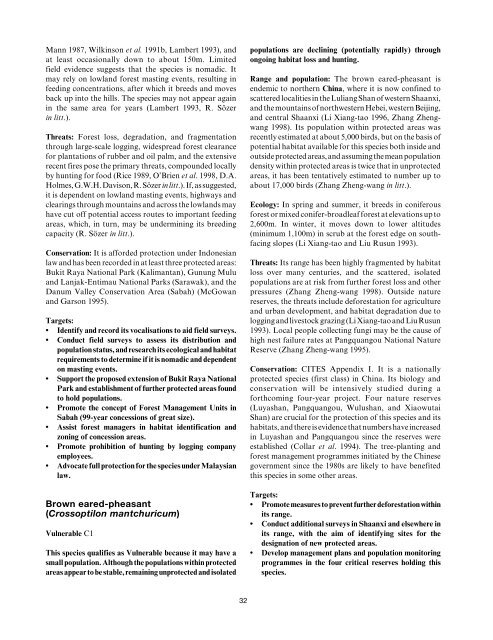Pheasants: Status Survey and Conservation Action Plan ... - IUCN
Pheasants: Status Survey and Conservation Action Plan ... - IUCN
Pheasants: Status Survey and Conservation Action Plan ... - IUCN
You also want an ePaper? Increase the reach of your titles
YUMPU automatically turns print PDFs into web optimized ePapers that Google loves.
Mann 1987, Wilkinson et al. 1991b, Lambert 1993), <strong>and</strong><br />
at least occasionally down to about 150m. Limited<br />
field evidence suggests that the species is nomadic. It<br />
may rely on lowl<strong>and</strong> forest masting events, resulting in<br />
feeding concentrations, after which it breeds <strong>and</strong> moves<br />
back up into the hills. The species may not appear again<br />
in the same area for years (Lambert 1993, R. Sözer<br />
in litt.).<br />
Threats: Forest loss, degradation, <strong>and</strong> fragmentation<br />
through large-scale logging, widespread forest clearance<br />
for plantations of rubber <strong>and</strong> oil palm, <strong>and</strong> the extensive<br />
recent fires pose the primary threats, compounded locally<br />
by hunting for food (Rice 1989, O’Brien et al. 1998, D.A.<br />
Holmes, G.W.H. Davison, R. Sözer in litt.). If, as suggested,<br />
it is dependent on lowl<strong>and</strong> masting events, highways <strong>and</strong><br />
clearings through mountains <strong>and</strong> across the lowl<strong>and</strong>s may<br />
have cut off potential access routes to important feeding<br />
areas, which, in turn, may be undermining its breeding<br />
capacity (R. Sözer in litt.).<br />
<strong>Conservation</strong>: It is afforded protection under Indonesian<br />
law <strong>and</strong> has been recorded in at least three protected areas:<br />
Bukit Raya National Park (Kalimantan), Gunung Mulu<br />
<strong>and</strong> Lanjak-Entimau National Parks (Sarawak), <strong>and</strong> the<br />
Danum Valley <strong>Conservation</strong> Area (Sabah) (McGowan<br />
<strong>and</strong> Garson 1995).<br />
Targets:<br />
• Identify <strong>and</strong> record its vocalisations to aid field surveys.<br />
• Conduct field surveys to assess its distribution <strong>and</strong><br />
population status, <strong>and</strong> research its ecological <strong>and</strong> habitat<br />
requirements to determine if it is nomadic <strong>and</strong> dependent<br />
on masting events.<br />
• Support the proposed extension of Bukit Raya National<br />
Park <strong>and</strong> establishment of further protected areas found<br />
to hold populations.<br />
• Promote the concept of Forest Management Units in<br />
Sabah (99-year concessions of great size).<br />
• Assist forest managers in habitat identification <strong>and</strong><br />
zoning of concession areas.<br />
• Promote prohibition of hunting by logging company<br />
employees.<br />
• Advocate full protection for the species under Malaysian<br />
law.<br />
Brown eared-pheasant<br />
(Crossoptilon mantchuricum)<br />
Vulnerable C1<br />
This species qualifies as Vulnerable because it may have a<br />
small population. Although the populations within protected<br />
areas appear to be stable, remaining unprotected <strong>and</strong> isolated<br />
populations are declining (potentially rapidly) through<br />
ongoing habitat loss <strong>and</strong> hunting.<br />
Range <strong>and</strong> population: The brown eared-pheasant is<br />
endemic to northern China, where it is now confined to<br />
scattered localities in the Luliang Shan of western Shaanxi,<br />
<strong>and</strong> the mountains of northwestern Hebei, western Beijing,<br />
<strong>and</strong> central Shaanxi (Li Xiang-tao 1996, Zhang Zhengwang<br />
1998). Its population within protected areas was<br />
recently estimated at about 5,000 birds, but on the basis of<br />
potential habitat available for this species both inside <strong>and</strong><br />
outside protected areas, <strong>and</strong> assuming the mean population<br />
density within protected areas is twice that in unprotected<br />
areas, it has been tentatively estimated to number up to<br />
about 17,000 birds (Zhang Zheng-wang in litt.).<br />
Ecology: In spring <strong>and</strong> summer, it breeds in coniferous<br />
forest or mixed conifer-broadleaf forest at elevations up to<br />
2,600m. In winter, it moves down to lower altitudes<br />
(minimum 1,100m) in scrub at the forest edge on southfacing<br />
slopes (Li Xiang-tao <strong>and</strong> Liu Rusun 1993).<br />
Threats: Its range has been highly fragmented by habitat<br />
loss over many centuries, <strong>and</strong> the scattered, isolated<br />
populations are at risk from further forest loss <strong>and</strong> other<br />
pressures (Zhang Zheng-wang 1998). Outside nature<br />
reserves, the threats include deforestation for agriculture<br />
<strong>and</strong> urban development, <strong>and</strong> habitat degradation due to<br />
logging <strong>and</strong> livestock grazing (Li Xiang-tao <strong>and</strong> Liu Rusun<br />
1993). Local people collecting fungi may be the cause of<br />
high nest failure rates at Pangquangou National Nature<br />
Reserve (Zhang Zheng-wang 1995).<br />
<strong>Conservation</strong>: CITES Appendix I. It is a nationally<br />
protected species (first class) in China. Its biology <strong>and</strong><br />
conservation will be intensively studied during a<br />
forthcoming four-year project. Four nature reserves<br />
(Luyashan, Pangquangou, Wulushan, <strong>and</strong> Xiaowutai<br />
Shan) are crucial for the protection of this species <strong>and</strong> its<br />
habitats, <strong>and</strong> there is evidence that numbers have increased<br />
in Luyashan <strong>and</strong> Pangquangou since the reserves were<br />
established (Collar et al. 1994). The tree-planting <strong>and</strong><br />
forest management programmes initiated by the Chinese<br />
government since the 1980s are likely to have benefited<br />
this species in some other areas.<br />
Targets:<br />
• Promote measures to prevent further deforestation within<br />
its range.<br />
• Conduct additional surveys in Shaanxi <strong>and</strong> elsewhere in<br />
its range, with the aim of identifying sites for the<br />
designation of new protected areas.<br />
• Develop management plans <strong>and</strong> population monitoring<br />
programmes in the four critical reserves holding this<br />
species.<br />
32
















